Art & Exhibitions
Artist Carrie Moyer Pokes (Just a Little) Fun at Our Collective Anxieties
Moyer's first solo exhibition with Alexander Gray Associates sees the artist mine both medium and zeitgeist, it's an exuberant, life-affirming respite from the doom-scroll news cycle.
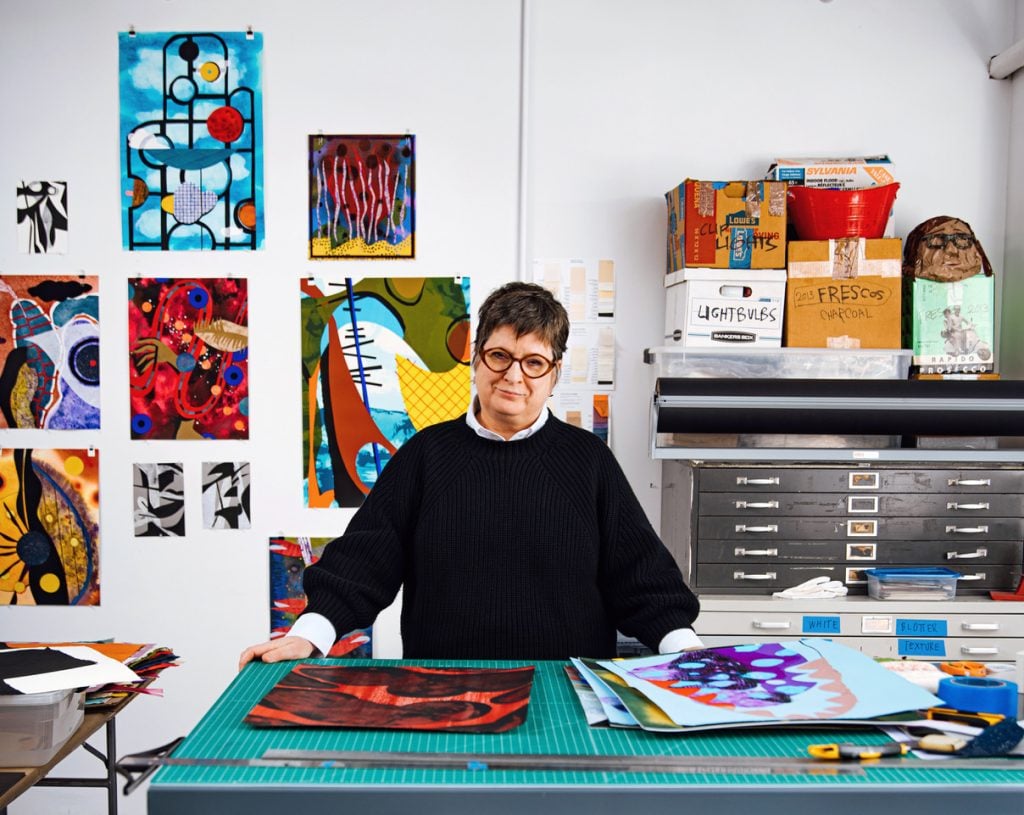
Times are tough. Whether it’s the economy, politics, social issues, or the environment, news headlines are consistently grim but nevertheless, life must carry on. “How do we live with the level of anxiety we have right now?” asked Carrie Moyer from within the midst of Alexander Gray Associates where her newest show was being installed earlier this month. “Maybe from a space that’s quiet, joyful, or self-mocking, that maybe pokes fun a little bit at our anxieties.”
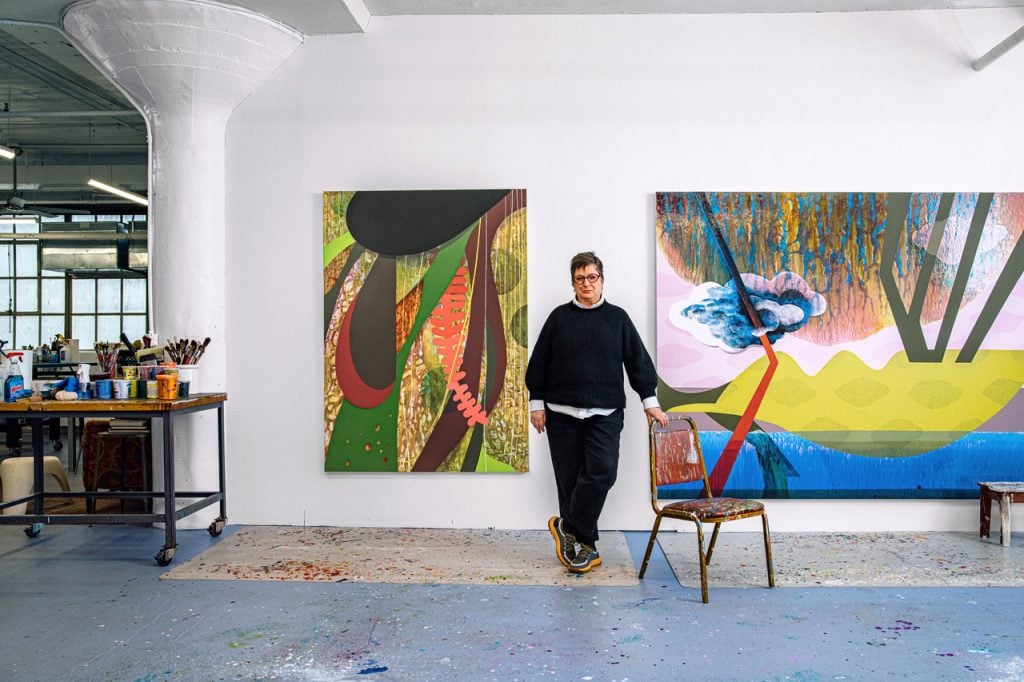
Carrie Moyer. Photo: Taylor Miller. Courtesy of Alexander Gray Associates, New York.
Though Moyer has worked with gallerist Alexander Gray for more than two decades, her solo show “Timber!” marks her first with the gallery. Comprised of new paintings and works on paper, the exhibition considers lived reality within the context of social and environmental instability and everything in between.
“I’m one of those painters who wants to please the viewer, so I’m always thinking about pleasure. But I’m thinking about pleasure in terms of politics, in terms of a bodily experience,” Moyer explained. “My wife helps me a lot with titles, so we had many discussions about this, and we were thinking about ‘timber’ like from comics—this is what you’d say when you’re telling everyone to take cover. It has a kind of Pop inflection because it’s not really something you’d say, but you might see it in a comic book.”
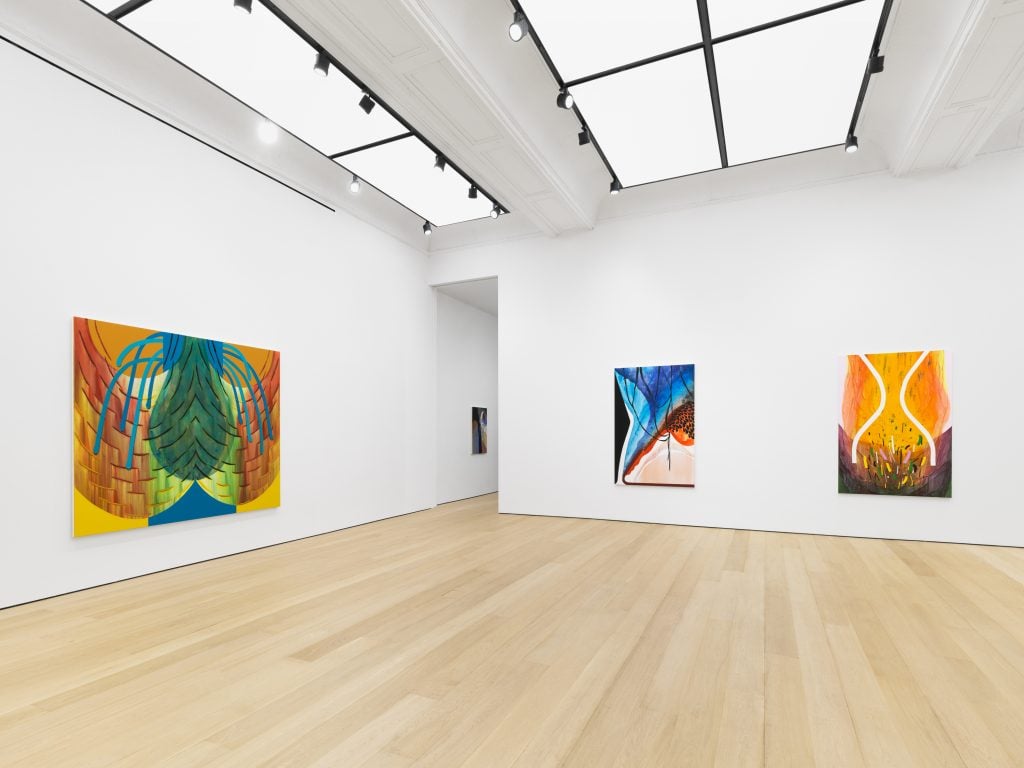
Installation view of “Carrie Moyer: Timber!” (2024). Photo: Dan Bradica. Courtesy of Alexander Gray Associates, New York.
While Moyer describes the speech-balloon-inspired “Timber!” as encapsulating how she’s been feeling, in other words, like everything is falling apart (something surely felt by many), the show is far from pessimistic. Instead, vibrant, mixed-media compositions offer a playfully abstract macro exploration of movements and processes from the natural world—whether the churning of magma and shifting of tectonic plates or planetary orbits and atmospheric currents.
In Tears on My Pillow (2024), the majority of the composition is overtaken by large swathes of color evoking elements of a landscape and draping tendrils, large black teardrop shapes rendered in sharp focus draw the eye. They reappear in larger number within Crying – Waiting – Hoping (2024) as well.
“They’re big drops that look like tears, they’re cartoonish, crazy, huge. They’re drops of paint, but they’re almost like an emoji,” said Moyer. The layered meanings or interpretations of the motif—as drops of paint both symbolically and literally, or as tears—speaks to Moyer’s preoccupation with modes of legibility. “In my work I often mix these kinds of graphic things that seem extremely readable with things that are very process oriented as a way of confounding both ways of reading, melding them together,” Moyer said.
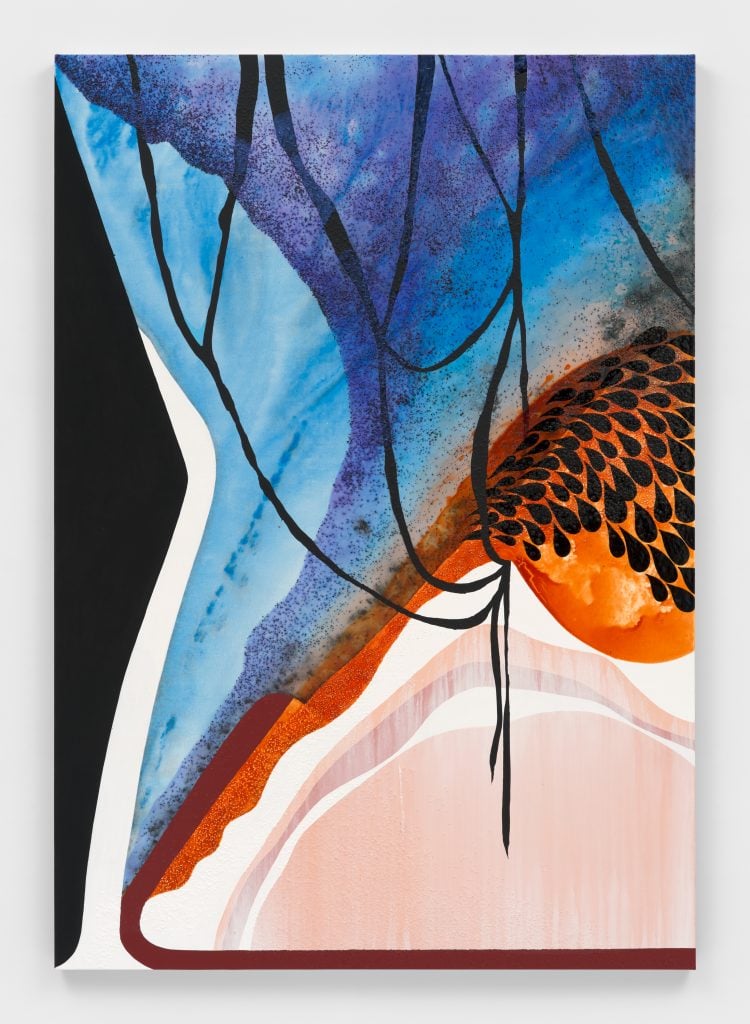
Carrie Moyer, Tears on My Pillow (2024). Courtesy of the artist and Alexander Gray Associates, New York.
It also brings to the fore Moyer’s penchant for experimenting with material and tapping its inherent origins and associations; apropos for a show that contemplates the end of the world, earthquakes, glacial shifts, and other doomsday paradigms. Paint pigments are frequently sourced from the earth like ochre or iron oxide, adding another layer of readability. In this new body of work, Moyer incorporates textural materials to her compositions, such as pumice in Tears on My Pillow, and powdered minerals from semi-precious stones, metal, and graphite in Etna’s Folly (2024). In a series of works on paper, salt has been delicately sprinkled over the piece, affecting the flow of watercolors and adding a distinctive texture to the surfaces.
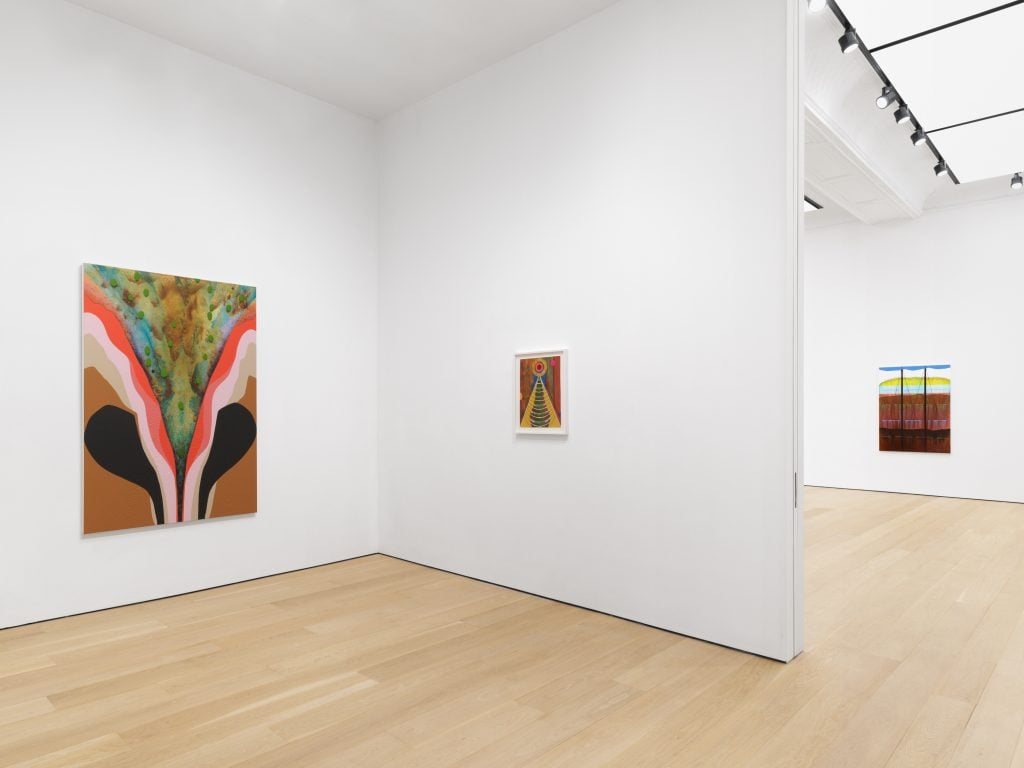
Installation view of “Carrie Moyer: Timber!” (2024). Photo: Dan Bradica. Courtesy of Alexander Gray Associates, New York.
The addition of unexpected materials is not something new to Moyer’s practice. Since the late 1990s, she has regularly added glitter to her paintings with the aim of complicating the effects of abstraction as well as a means of exploring themes around gay identity. This early material experimentation was also deeply engaged with art history and traditional ideas of what made a painting “good.”
“I don’t think this affects younger painters in the way that it did when I was younger, but it used to be that if you were painting acrylic paint, it needed to be flat. You couldn’t show a brush stroke. There were all these weird constraints and conventions that went along with the material itself,” the artist noted. Moyer’s present paintings continue to toy with these notions, including sealing textural materials under layers of paint, so the shadows cast from the disrupted flatness become physical, “contaminating” the formal elements.
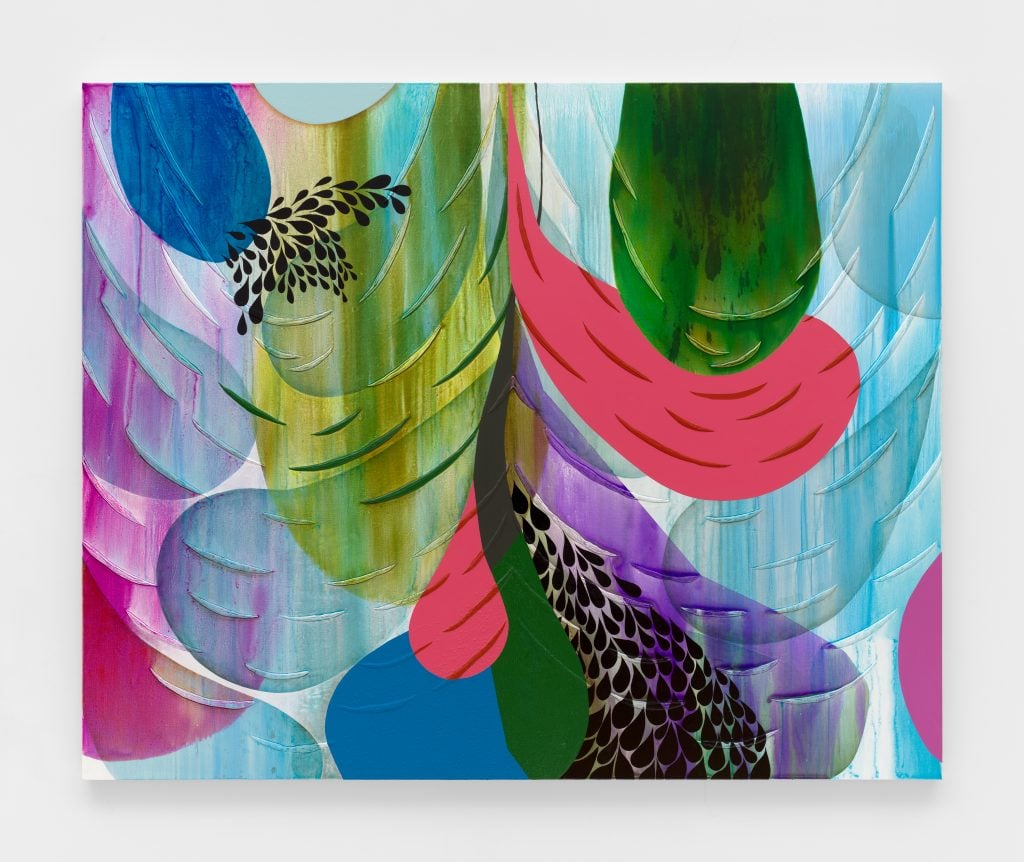
Carrie Moyer, Crying – Waiting – Hoping (2024). Courtesy of the artist and Alexander Gray Associates, New York.
Citing a longstanding interest in the legacy of color field painting, which contrary to immaculate flatness instead sought to physically saturate the canvas, Moyer’s paintings frequently vacillate between sections of impenetrable opacity and sheer veils of poured paint—but, ultimately, this is only an illusion. Though many of the passages are poured, the paint doesn’t sit on raw canvas, there is gesso priming the canvas before it even touches the surface. The addition of three dimensional medium like fiber paste, which has a texture similar to paper, allows the surface to be built up, as can be seen in the oblong shapes dotting Crying – Waiting – Hoping, where the paint at times seamlessly envelopes masses and at others appears to drip off its ends. In a manner of speaking, the combination of elements results in a type of “painting joke.”
“I grew up as a painter in this transition between the death of Modernism and Post-Modernism, so part of me has some set of conventions about what ‘real’ painting is and what painting does intellectually, physically, optically, but then also I’m like ‘Oh my god, listen to yourself!’ No one in good conscience could be strict about any of this anymore or take it too seriously.”
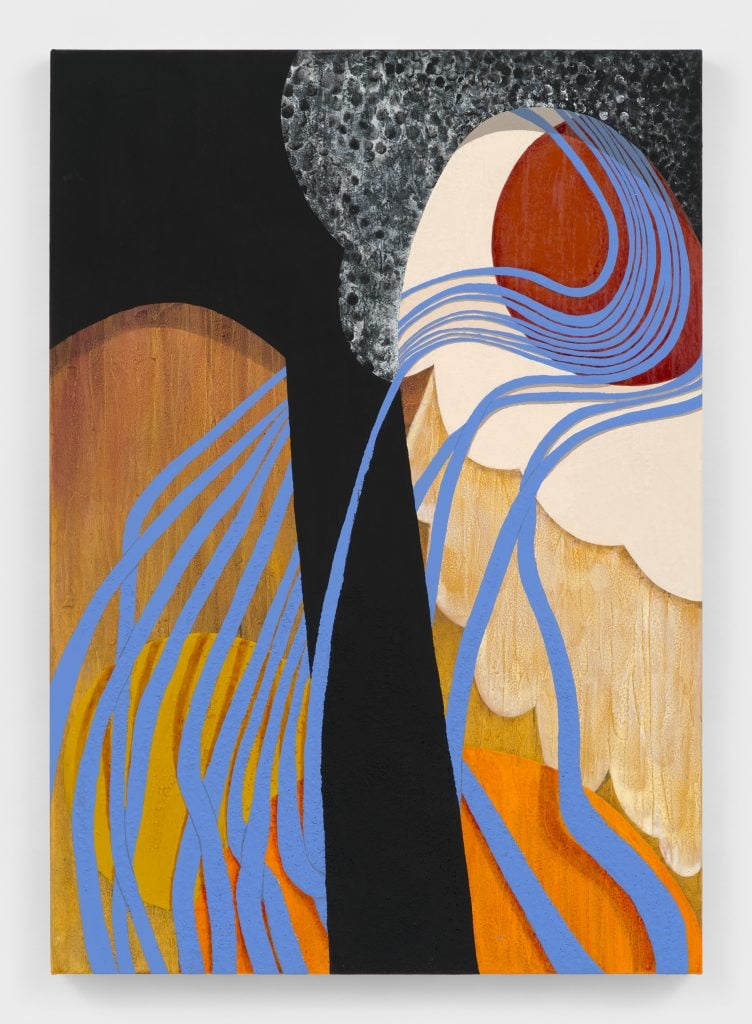
Carrie Moyer, Mommy Long Legs (2024). Courtesy of the artist and Alexander Gray Associates, New York.
Is the world ending? Maybe. Is contemporary lived reality overwhelming and anxiety inducing? Certainly. But continue we must. And it is at this juncture that Moyer finds a bit of humor in the situation. Collapsing the distance between human and cosmic scale, “Timber!” confronts a range of serious topics—from art historical canon to natural disaster—with a playfulness and repose that viewers can take a step back and take stock of the magnitude of their and the world’s situation, but perhaps too even have a small laugh at themselves.





